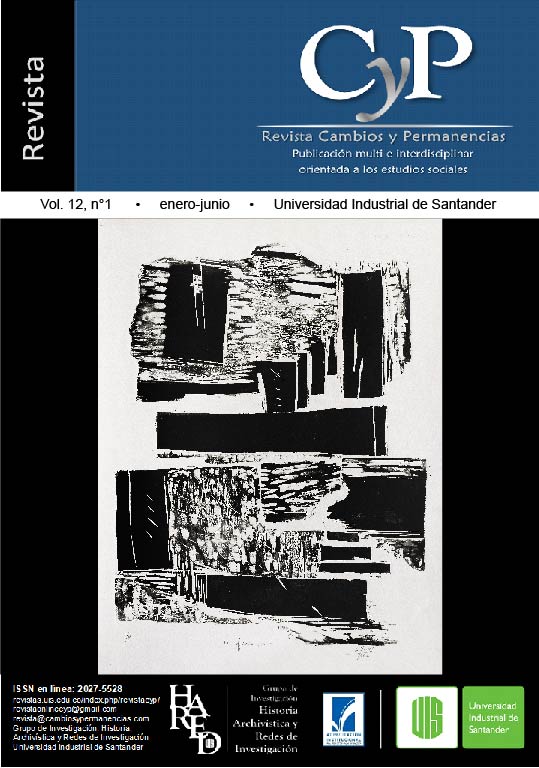A historical view of haciendas and rural spaces: dynamics and representations in full-length films
Published 2021-06-30
Keywords
- hacienda serrana (mountain range estate),
- urban-rural relations,
- agrarian reform,
- citizenship exclusion,
- land appropriation
How to Cite
Abstract
In the following paper we aim to examine the hacienda serrana dynamics (mountain range estate dynamics) and its representations depicted in Ecuadorian films, produced between 2009 and 2014. We focus on the movie Feriado, by Diego Araujo, from which we trace pertinent links with other films: Impulso, by Mateo Herrera, En el nombre de la hija, by Tania Hermida and El Facilitador, by Víctor Arregui. These four fictional films take the hacienda as a spatial, and even narrative, center of interest, although their plot may be placed in psychological and identity aspects of the characters.
In order to define links between the grasp and the representation of the hacienda, we frame this study in a historical characterization of key elements of the hacienda, such as the ruptures of the agrarian reforms, angular accents of the XIX century and constitutive references in the colonial period. We also analyze the recurrent themes of its filmic representation produced in the character trajectories, characters which we conceive as iconic representations of social inhabitants of these experiential and transforming rural spaces.
Downloads
References
Borchart de Moreno, C. (1980). La transferencia de la propiedad agraria indígena en el corregimiento de Quito hasta finales del siglo XVII. Cahiers du monde hispanique et luso-brésilien, 34, 5-19. Recuperado de https://www.persee.fr/doc/carav_0008-0152_1980_num_34_1_1499
Borchart de Moreno, C. (1991). Origen y conformación de la hacienda colonial. En E. Ayala Mora (Edit.), Nueva Historia del Ecuador (pp. 139-166), Vol. 4, Época Colonial II. Quito, Ecuador: Corporación Editora Nacional / Grijalbo.
Borchart de Moreno, C. (1998). La Audiencia de Quito. Aspectos económicos y sociales (siglos XVI-XVIII). Quito, Ecuador: Banco Central del Ecuador / Abya-Yala.
De Certeau, M. (1994). La escritura de la Historia. México: Universidad Iberoamericana.
Deler, J. P., Gómez, N., y Portais, M. (1983). El manejo del espacio en el Ecuador. Etapas claves. Geografía Básica del Ecuador. Tomo I. Quito, Ecuador: Instituto Geográfico Militar.
Guerrero, A. (1991). La semántica de la dominación: el concertaje de indios. Quito, Ecuador: Libri Mundi.
Guerrero, A. (2010). Administración de poblaciones, ventriloquía y transescritura. Análisis históricos: estudios teóricos. Quito, Ecuador: FLACSO / Instituto de Estudios Peruanos.
Harper, G., y Rayner, J. (2010). Introducción. Cine y paisaje. En G. Harper y J. Rayner (Edits.), Cinema and Lanscape. Malta: Gutenberg Press.
Mottet, J. (2011). Du paysage à l’expérience sensible du monde: la forêt dans le cinéma contemporain. En A. Corvol (Coord.), Forêt et paysage. Xe-XXIe siècle (pp.201-219). París, Francia: L’Harmattan.
Velasco, F. (1979). Reforma agraria y movimiento campesino indígena de la Sierra. Hipótesis para una investigación. Quito, Ecuador: Editorial El Conejo.
Filmografía
Herrero, M. (director). (2009). Impulso [Cinta cinematográfica]. Quito, Ecuador: Taladro Films.
Parra, I. (productora) y Arregui, V.(director). (2013). El facilitador [Cinta cinematográfica]. Ecuador: Caleidoscopio Cine / Geoimagen Chile / Blackbox Studioz.
Parrini, P. (productora) y Hermida, T. (directora). (2011). El nombre de la hija [Cinta cinematográfica]. Ecuador: Corporación Ecuador para Largo.
Skartveit, H. L. (productora) y Araujo, D., (director). (2014). Feriado [Cinta cinematográfica]. Quito, Ecuador: Luna films Audiovisual / CEPA Audiovisual / Abaca Films.

